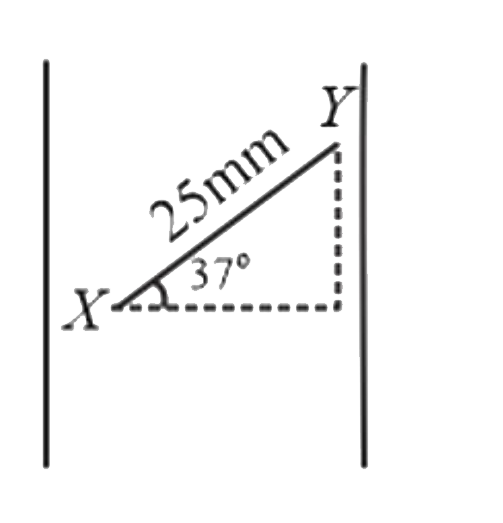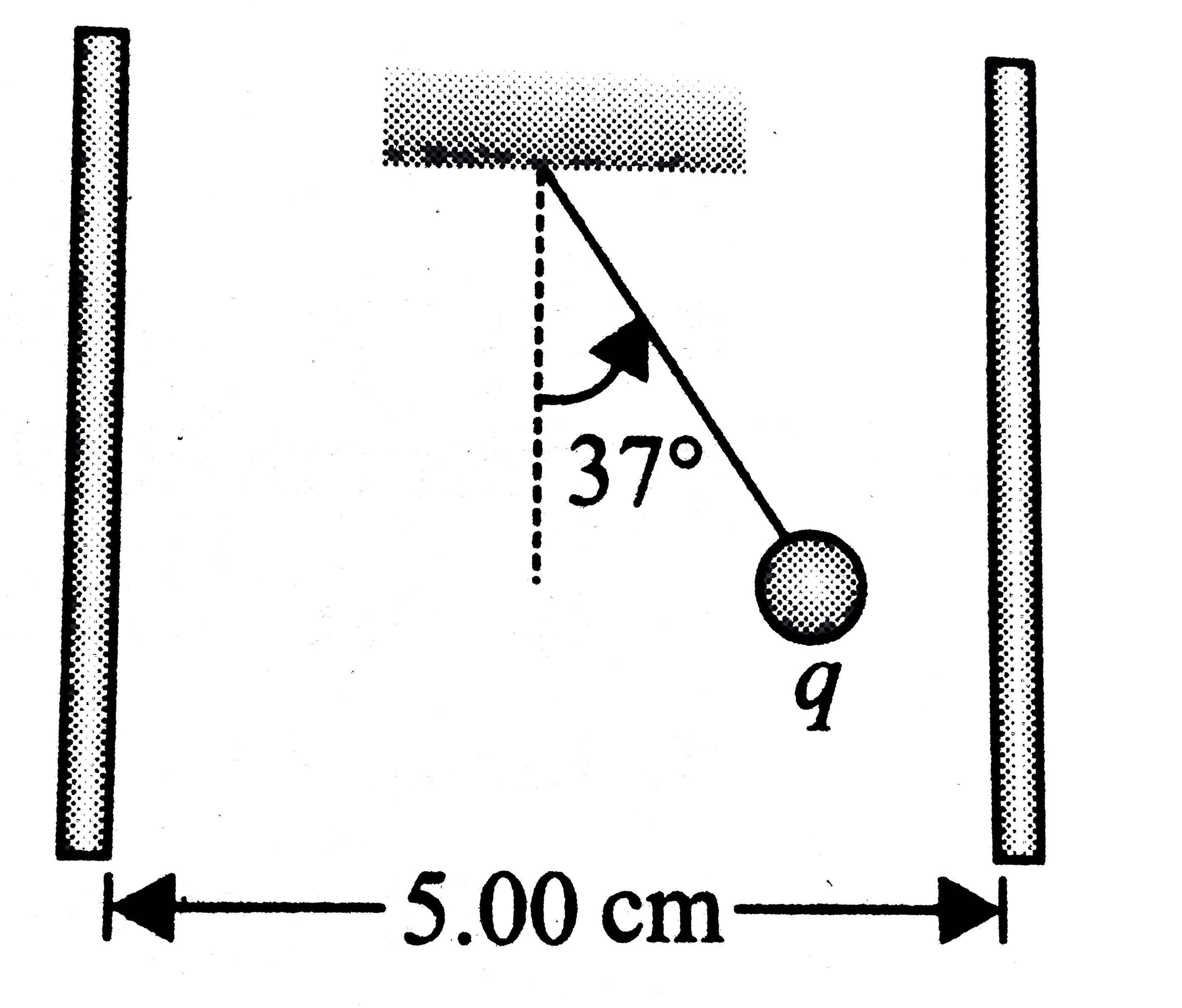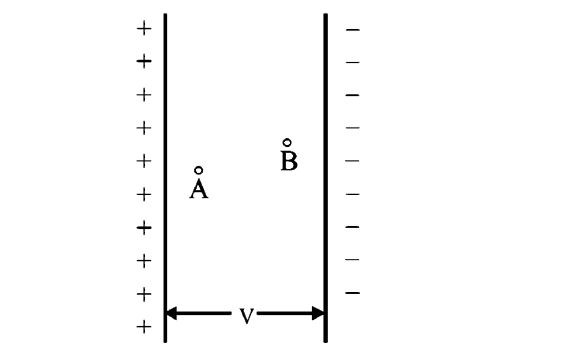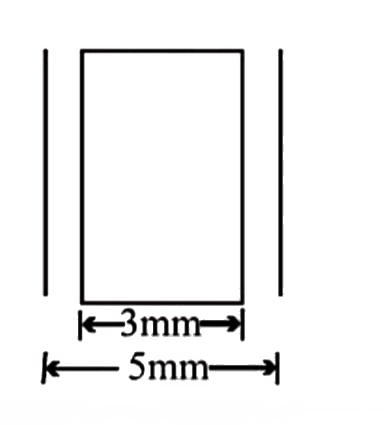A small oil drop of mass 10−6 kg is hanging in at rest between two plates separated by 1 mm having in at rest between two plates separated by 1 mm having a potential difference of 500 V. The charge on the drop is (g=10ms−2)
2×10−9C
2×10−11C
2×10−6C
2×10−9C
The correct Answer is:D
To find the charge on the oil drop, we can follow these steps:
Step 1: Identify the forces acting on the oil drop
The oil drop is acted upon by two forces:
1. The gravitational force (weight) acting downwards, given by Fg=mg.
2. The electric force acting upwards, given by Fe=QE.
Step 2: Calculate the gravitational force
Given:
- Mass of the oil drop, m=10−6 kg
- Acceleration due to gravity, g=10m/s2
The gravitational force is calculated as:
Fg=mg=(10−6kg)(10m/s2)=10−5N
Step 3: Calculate the electric field between the plates
The electric field E between two parallel plates is given by the formula:
E=Vd
where:
- V=500V (potential difference)
- d=1mm=1×10−3m
Substituting the values:
E=500V1×10−3m=500000V/m=5×105V/m
Step 4: Set the electric force equal to the gravitational force
Since the drop is at rest, the net force acting on it is zero, which means:
Fe=Fg
Thus, we have:
QE=mg
Step 5: Solve for the charge Q
Rearranging the equation gives:
Q=mgE
Substituting the values:
- mg=10−5N
- E=5×105V/m
Calculating Q:
Q=10−5N5×105V/m=10−55×105=2×10−11C
Final Answer
The charge on the oil drop is Q=2×10−11C.
---
The oil drop is acted upon by two forces:
1. The gravitational force (weight) acting downwards, given by Fg=mg.
2. The electric force acting upwards, given by Fe=QE.
Given:
- Mass of the oil drop, m=10−6 kg
- Acceleration due to gravity, g=10m/s2
Fg=mg=(10−6kg)(10m/s2)=10−5N
The electric field E between two parallel plates is given by the formula:
E=Vd
where:
- V=500V (potential difference)
- d=1mm=1×10−3m
E=500V1×10−3m=500000V/m=5×105V/m
Since the drop is at rest, the net force acting on it is zero, which means:
Fe=Fg
Thus, we have:
QE=mg
Rearranging the equation gives:
Q=mgE
- mg=10−5N
- E=5×105V/m
Q=10−5N5×105V/m=10−55×105=2×10−11C
The charge on the oil drop is Q=2×10−11C.
Topper's Solved these Questions
- ELECTROSTATIC POTENTIAL AND CAPACITORSBook:DC PANDEY ENGLISHChapter:ELECTROSTATIC POTENTIAL AND CAPACITORSExercise:(B) Chapter exercises
Explore 17 Videos
- ELECTROMAGNETIC WAVESBook:DC PANDEY ENGLISHChapter:ELECTROMAGNETIC WAVESExercise:Sec C
Explore 22 Videos
- ELECTROSTATICSBook:DC PANDEY ENGLISHChapter:ELECTROSTATICSExercise:Medical entrances gallery
Explore 37 Videos
Similar Questions
A particle of mass 1.96×10−15 kg is kept in equilibrium between two horizontal metal plates having potential difference of 400 V separated apart by 0.02 m. then the charge on the particle is (e= electronic charge)
View SolutionTwo large parallel conducting plates are separated by 40 mm. The potential difference between the plates is V. Potential difference between points X and Y as indicated in the figure will be

View SolutionTwo square plates are at potential difference of 100V separated by 2cm. Calculate electric intensity between them
View SolutionA small sphere with mass 1.2g hangs by a thread between two parallel vertical plates 5.00cm apart. The plates are insulating and have uniform surface charge densities +σand−σ. The charge on the sphere is q=9×10−6C. What potential difference between the plates will cause the thread to assume an angle of 37∘ with the vertical as shown in (Fig. 3.134) ?
 .
.
View SolutionIn a parallel plate capacitor of capacitor 1μF two plates are given charges 2μC and 4μC the potential difference between the plates of the capacitor is
_2019_CBT2_E01_002_Q01.png)
View SolutionIn Millike's oil drop experiment an oil drop carrying a charge Q is held stationary by a potential difference 2400V between the plates. To keep a drop of half the radius stationary the potential difference had to be made 600V. What is the charge on the second drop ?
View SolutionThe capacitance of a parallel plate capacitor is 400 picofarad and its plates are separated by 2 mm of air
( i) What will be the energy when it is charged to 1500 volts ?
(ii) What will be the potential difference with the same charge if separation is doubled ?
(iii) How much energy is need to double the distance between its plates ?
View SolutionTwo protons A and B are placed in between the two plates of a parallel plate capacitor charged to a potential difference V as shown in the figure. The forces on the two protons are identical.

View SolutionA charged oil drop of mass 2.5×10−7kg is in space between the two plates, each of area 2×10−2m2 of a parallel plate capacitor. When the upper plate has a charge of 5×10−7C and the lower plate has an equal negative charge, then the oil remains stationary. the charge of the oil drop is (take, g=10m/s2)
View SolutionSeparation between the plates of parallel plate capacitor is 5 mm. this capacitor, having air as the dielectric medium between the plates, is charged to a potential difference 25 V using a battery. The battery is then disconnected and a dielectric slab of thickness 3mm and dielectric constant K=10 is placed between the plates as shown. potential difference between the plates after the dielectric slab has been introduced is-

View Solution
